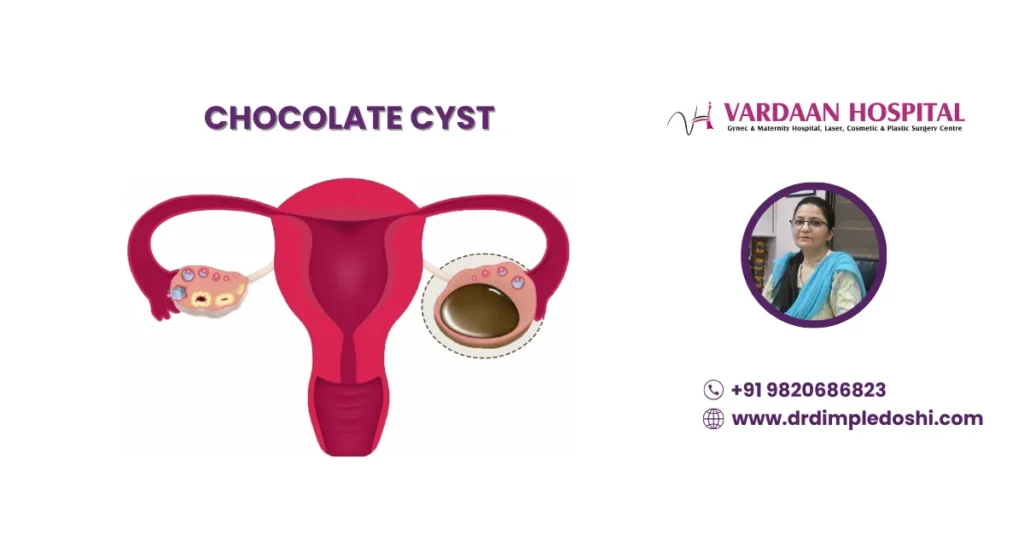Chocolate Cysts: Causes, Symptoms, Diagnosis & Treatment

What Are Chocolate Cysts?
Chocolate cysts, also known as ovarian endometriomas, are non-cancerous cysts filled with chocolate coloured fluid that contains old blood and tissues. As old and collected blood is brown in colour and, chocolate-like; the name chocolate cyst became popular. They are commonly associated with endometriosis, a condition where the tissue lining the uterus grows outside the uterine cavity, often affecting the ovaries, fallopian tubes, pelvic structures and the uterine musculature causing adenomyosis
Chocolate cysts develop when endometrial tissue implants on or inside the ovary. Endometrial tissues are hormone-responsive. So, this leads to internal bleeding, causing blood accumulation within the cyst. Over time, the collected blood darkens, giving the cyst its characteristic chocolate brown colour
While some chocolate cysts remain asymptomatic, many women experience distressing symptoms, including:
- Chronic pelvic pain,
- Painful periods (dysmenorrhea)
- Pain during intercourse (dyspareunia)
- Difficulty in conceiving (infertility)
- Chronic lower abdominal discomfort
- Irregular menstrual cycles
- If associated with DIE (Deep infiltrating endometriosis); bowel and bladder symptoms like painful defecation and painful urination with bleeding may be present.
Notably, the severity of symptoms does not always correlate with the cyst size—small cysts can cause intense pain, while occasionally larger cysts may not be so painful.
If you experience pelvic pain, difficulty conceiving, or pain during intercourse, consult a gynaecologist immediately. A thorough diagnosis typically involves:
- Medical History & Symptom Evaluation
- Pelvic Examination – The gynaecologist may detect cysts through physical examination.
- Ultrasound Imaging – A pelvic ultrasound provides a detailed view of ovarian cysts.
- MRI– to know the proper extent of the disease
Laparoscopy – A minimally invasive procedure that helps diagnose endometriosis and detect small chocolate cysts.
The treatment approach depends on factors such as age, symptoms, cyst size, ovarian involvement, extent of endometriosis and future pregnancy plans.
Conservative (Non-Surgical) Treatment
For small, asymptomatic cysts, especially in young girls; doctors may recommend:
- Hormonal Therapy: Birth control pills or GnRH agonists help manage symptoms and slow cyst growth, though they do not eliminate the cysts.
- Pain Management: Medications like ibuprofen, naproxen, or drotaverine can relieve pain.
Surgical Treatment
Surgery is considered if:
- Cysts are large (typically over 4-5 cm)
- There is persistent pain despite medication
- Infertility issues arise
- If it is associated with DIE (Deep infiltrating endometriosis)
Laparoscopic chocolate cystectomy is most of the times not an isolated surgery but it also involves doing excisional surgery for pelvic endometriosis and DIE (Deep infiltrating endometriosis) along with it.
During Laparoscopic Chocolate Cystectomy (keyhole surgery), cyst wall removal is done while preserving ovarian function.
Type 1 Chocolate Cysts: Small (<5 cm), deep-seated within the ovary, and challenging to remove.
Type 2 Chocolate Cysts: Larger, superficial, and easier to excise.
Chocolate cysts are benign in most cases, with only 0.5% to 1% progressing to malignancy. Rarely, endometrioid carcinoma and clear cell adenocarcinoma may develop in women with long-standing endometriosis.

